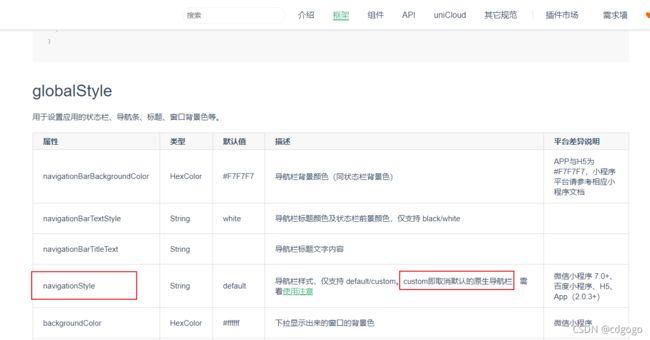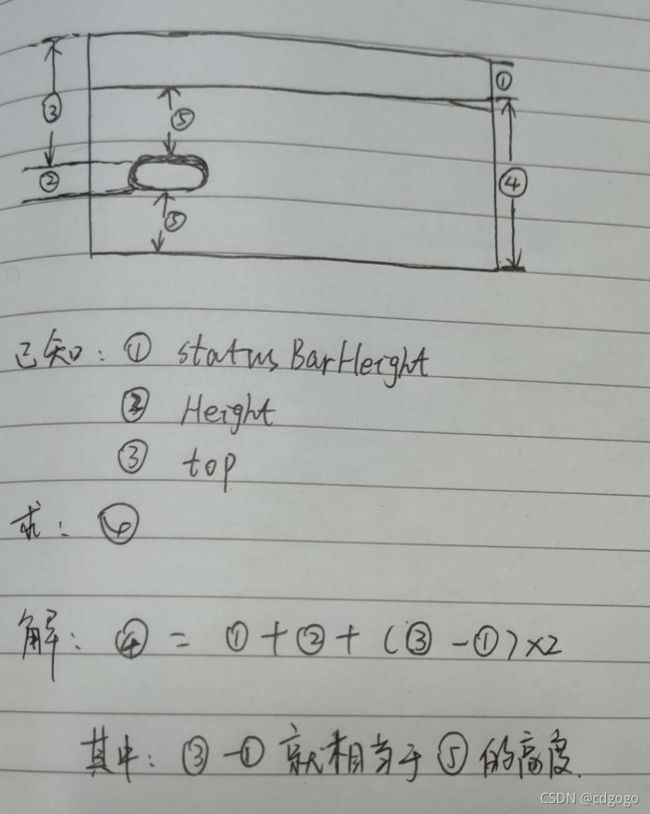【微信小程序】自定义导航栏
大部分情况下我们都是使用微信官方自带的 navigationBar 配置 ,但有时候我们需要在导航栏集成搜索框、自定义背景图、返回首页按钮等。
思路
- 隐藏官方导航栏
- 获取胶囊按钮、状态栏相关数据以供后续计算
- 根据不同机型计算导航栏高度
- 编写新的导航栏
- 页面引用自定义导航
一、隐藏官方导航栏
隐藏导航栏可以全局配置,也可以单独页面配置,具体根据业务需求来。

{
"path" : "pages/public/login",
"style": {
"navigationBarTitleText": "",
"navigationStyle": "custom",
"app-plus": {
"titleNView": false
}
}
}
二、计算相关值
因为在不同的手机型号头部那条栏目高度可能不一致,所以为了我们适配更多型号,我们需要计算3个值:
- 整个导航栏的高度;
- 胶囊按钮与顶部的距离;
- 胶囊按钮与右侧的距离。
小程序可以通过 wx.getMenuButtonBoundingClientRect() 获取胶囊按钮的信息 和 wx.getSystemInfo() 获取设备信息。
1、整个导航栏高度 = statausBarHeight + height + (top-statausBarHeight )2;
注:状态栏到胶囊的间距 = 胶囊到下边界距离。所以这里需要2
(或: 导航栏高度 = bottom + ( top- statausBarHeight ) )
2、胶囊按钮与顶部的距离 = top;
3、胶囊按钮与右侧的距离 = windowWidth - right。
关于第1步中,为啥要乘以2的原因,请看灵魂画手般的我画的图纸:

实例
app.js设置
一般情况下,我们需要在运用启动的初始化生命周期钩子进行计算相关的数据,也就是入口文件 app.js 的 onLaunch 生命周期钩子
App.js 代码如下:
// app.js
App({
globalData: {
},
onLaunch() {
this.setNavBarInfo();
},
setNavBarInfo(){
let menuButtonObject = wx.getMenuButtonBoundingClientRect();
wx.getSystemInfo({
success: res => {
let statusBarHeight = res.statusBarHeight,
navTop = menuButtonObject.top,//胶囊按钮与顶部的距离
navHeight = statusBarHeight + menuButtonObject.height + (menuButtonObject.top - statusBarHeight) * 2;//导航高度
this.globalData.navHeight = navHeight;
this.globalData.navTop = navTop;
this.globalData.windowHeight = res.windowHeight;
},
fail(err) {
console.log(err);
}
})
}
})
组件封装
因为这个头部导航是公共的,所以我们最好把它设置成一个组件,命名为navbar

index.wxml
<view class="navbar custom-class" style='height:{{navHeight}}px;background-color:{{bgColor}}'>
<view wx:if="{{showNav}}" class="navbar-action-wrap navbar-action-group row item-center" style='top:{{navTop}}px;background-color:rgba(255,255,255,.6)'>
<ss-icon name="back" color="{{iconColor}}" size="15px" block="{{true}}" class="navbar-action_item" bind:click="_navBack">ss-icon>
<ss-icon name="index" color="{{iconColor}}" size="15px" block="{{true}}" class="navbar-action_item last" bind:click="_toIndex">ss-icon>
view>
<view class='navbar-title' style="top:{{navTop}}px; {{ textColor ? 'color: ' + textColor : '' }}">
{{pageName}}
view>
view>
index.js
// components/navbar/index.js
const App = getApp();
Component({
options: {
addGlobalClass: true,
},
/**
* 组件的属性列表
*/
properties: {
pageName:String,
bgColor:{
type:String
},
iconColor:{
type:String,
value:"#000"
},
textColor:{
type:String,
value:"#000"
},
showNav:{
type:Boolean,
value:true
},
showHome: {
type: Boolean,
value: true
}
},
/**
* 组件的初始数据
*/
data: {
navTop:App.globalData.navTop,
navHeight: App.globalData.navHeight
},
lifetimes: {
attached: function () {
this.setData({
navH: App.globalData.navHeight
})
}
},
/**
* 组件的方法列表
*/
methods: {
//回退
navBack: function () {
wx.navigateBack({
delta: 1
})
},
//回主页
toIndex: function () {
wx.navigateTo({
url: '/pages/admin/home/index/index'
})
},
}
})
index.wxss
/* components/navbar/index.wxss */
.navbar {
width: 100%;
overflow: hidden;
position: relative;
top: 0;
left: 0;
z-index: 10;
flex-shrink: 0;
}
.navbar-title {
width: 100%;
box-sizing: border-box;
padding-left: 115px;
padding-right: 115px;
height: 32px;
line-height: 32px;
text-align: center;
position: absolute;
left: 0;
z-index: 10;
color: #333;
font-size: 16px;
font-weight: bold;
text-overflow: ellipsis;
overflow: hidden;
white-space: nowrap;
}
.navbar-action-wrap {
display: -webkit-flex;
display: flex;
-webkit-box-align: center;
-ms-flex-align: center;
-webkit-align-items: center;
align-items: center;
position: absolute;
left: 10px;
z-index: 11;
line-height: 1;
padding-top: 4px;
padding-bottom: 4px;
}
.navbar-action-group {
border: 1px solid #f0f0f0;
border-radius: 20px;
overflow: hidden;
}
.navbar-action_item {
padding: 3px 0;
color: #333;
}
.navbar-action-group .navbar-action_item {
border-right: 1px solid #f0f0f0;
padding: 3px 14px;
}
.navbar-action-group .last {
border-right: none;
}
index.json:
{
"component": true,
"usingComponents": {
"ss-icon": "../icon/index"
}
}
ss-icon 是我自定义的一个 icon 组件,点击查看。 如果你没有这个组件,可以在我使用的地方换成组件,然后里面放入你的图标就可以了。
对于组件不太明白的,可以看下微信小程序组件相关组件的介绍。
组件已创建完毕,现在说下该组件的使用方法:
组件使用
假设我们需要在index.wxml中需要调用这个组件,
1.在index.json中引用该组件:
{
"usingComponents": {
"navbar": "/components/navbar/index"
}
}
2.在index.wxml中使用该组件:
<view class='view-page'>
<navbar page-name="测试" bg-color="#1c92ee" icon-color="#fff" text-color="#fff" show-nav="{{true}}">navbar>
<view class='page-content'>
view>
view>
| 参数 | 说明 | 类型 | 默认值 |
|---|---|---|---|
| page-name | 当前页面名称 | String | – |
| show-nav | 是否显示左侧图标按钮 | Boolean | true |
| bg-color | 导航背景颜色 | String | #fff |
| icon-color | 左侧图标颜色 | String | #000 |
| text-color | 当前页面名称颜色 | String | #000 |
完整代码git地址:微信小程序-自定义导航栏
参考
微信小程序——自定义导航栏
【微信小程序】自定义导航栏(二)


